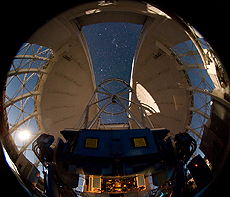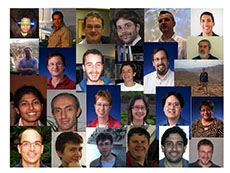The sky is not the limit: DES gets time on Gemini telescope
 |
| The Dark Energy Survey was recently awarded 276 hours on the Gemini South telescope. Photo: Gemini Observatory/Association of Universities for Research in Astronomy
|
In an ambitious five-year mission, the Dark Energy Survey team has devoted itself to mapping the southern sky in unprecedented detail, ultimately hoping to decipher what may stand as the most bewildering phenomenon of our expanding universe.
In March, DES applied to the Large and Long Program at the Gemini Observatory, a program meant to foster scientific exploration through global collaboration. Although the Gemini Observatory has existed since 2000, the Large and Long Program launched just last year as another means to probe the shrapnel of the big bang. It offers time on two of the world's finest telescopes, one located atop an 8,900-foot mountain in the Chilean Andes (Gemini South) and the other on Mauna Kea, Hawaii (Gemini North).
Just last month, co-leader of the Strong Lensing Science Working Group at DES, Liz Buckley-Geer, received the email she'd been waiting for: Spread over the next three years, DES had been awarded a lofty total of 276 hours on Gemini South.
"Because we were asking for such a big block of time I really didn't think we had much of a chance," Buckley-Geer said. "I was pretty gobsmacked when I got the email two weeks ago."
With a hefty 8.1-meter mirror, the Gemini telescope is twice as large as the telescope on which DECam is currently mounted. But DES scientists don't plan to take new images with Gemini South. DECam images are plenty clear and show high-quality snapshots of galaxies and galaxy clusters. Instead of imaging, DES scientists will use an instrument called a spectrograph to further inspect the images and, in some cases, confirm a rare phenomenon called strong lensing.
One of five methods DES uses to explore dark energy, strong lensing is the bending of light from a distant galaxy, or source, due to the gravitational influence of a massive foreground object, or lens. Lensing changes the observed shape of the distant galaxy and intensifies brightness. To find these strong lensing systems in the DECam images, DES scientists look for objects that look distorted, often appearing as long bright arcs, multiple blue knots or, in the rarest cases, an Einstein ring. DES will focus on certain classes of strong lenses that can be used to study dark energy.
"The strong lenses provide a kind of peephole to the more distant, fainter universe that wouldn't be available if the lenses weren't there," said DES Operations Scientist Tom Diehl.
But what appear to be strong lenses are not always so. To separate the lenses from the impostors, scientists measure the redshifts of both the lens and the source. A true strong lens is one in which the source redshift is larger than the lens redshift.
A redshift occurs when light wavelengths increase, or shift toward the red side of the electromagnetic spectrum. The measured redshift of a galaxy is related to the expansion of the universe as a function of time, and it allows DES scientists to calculate the distance to the object.
To determine the redshift of a galaxy, the scientists will compare the spectrum of the obtained light with known features in the spectrum of various chemical compounds found on Earth. If the same features are seen in an observed spectrum from a distant source but occur at shifted wavelengths, then the redshift can be calculated.
"The observations with Gemini will give us the redshifts of all these objects, and armed with that information we can move on to the next step," Buckley-Geer said. "It's not all the information we need, but it's one piece of the jigsaw puzzle closer to understanding these system in relation to dark energy."
—Hanae Armitage
 |
| Pictured are some of the 29 Dark Energy Survey scientists from Australia, Brazil, Japan, Switzerland, Taiwan, the United Kingdom and the United States who were involved in the Gemini proposal. Image courtesy of Elizabeth Buckley-Geer, SCD
|
|